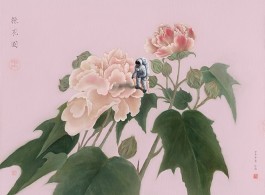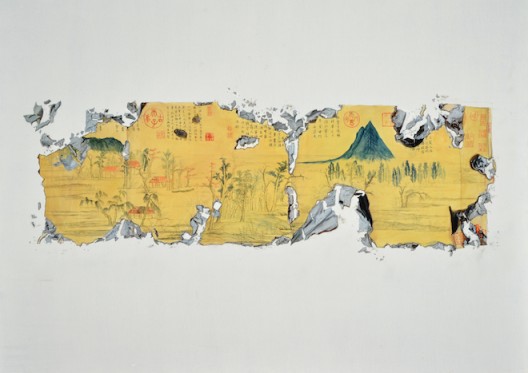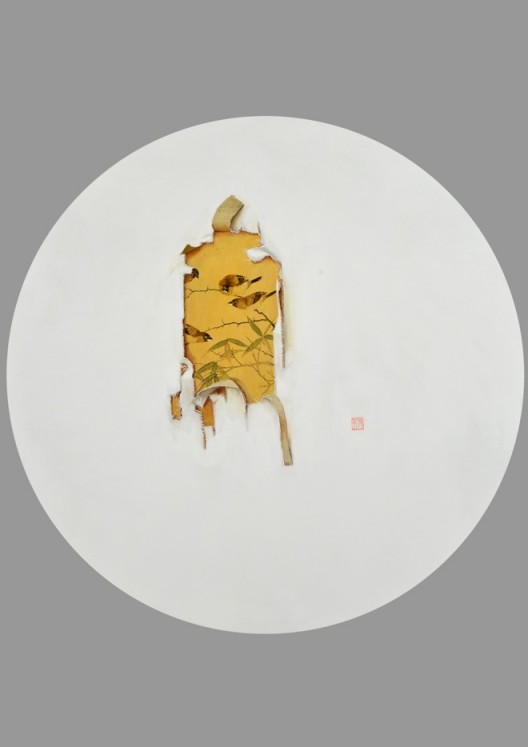In April last year, Zhang Zheyi and Chen Jiaye took part in Red Gate Gallery’s group exhibition “Altered Shan Shui States”; marking the beginning of their collaboration with Red Gate, as well as the beginning of their friendship.
In this exhibition, “Highly Prized Flowers” (Tan Hua)1, the two artists continue their earlier re-imagining and re-creation of the tradition of classical Chinese painting. Setting out from a contemporary standpoint, they hark back to tradition, providing alternate interpretations of tradition by tackling subject matter that ranges from the traditional genre of landscape (shan shui) paintings to flower and bird (hua niao) and figural (ren wu) genres and by relying on their different experiences of life and artistic insights.
Harking back to tradition and drawing on it as a reflective mirror is not the same thing as simply returning to the past, nor does it necessarily point to cultural conservatism. The artist Xu Bing recently said in an interview that “the environment in which I grew up and the education I had were influenced by Chinese tradition and the socialist period. In making art, if I don’t utilize these traditions, what are the alternatives, American culture? International culture?”2 In fact each generation of artists creates within an established artistic tradition or reality, and as either inheritors or rebels they cannot escape this influence. In contemporary society, tradition exists in all its complexity, however mottled, fragmentary, multi-faceted and permeable this might be. The social and cultural context of artistic traditions has long since undergone irreversible change, and the revival of a tradition in any fundamentalist sense is neither possible nor desirable. Yet, as a part of collective cultural memory it exists as a reserve of images that provide the creative background for contemporary artists.
The creative work of Zhang Zheyi and Chen Jiaye is fully cognizant and expressive of this complexity, and their attempts to break through the binary opposition between the “traditional” and the “contemporary” make the tradition relevant for what is of the moment, at the same time as the contemporary is imbued with historical dimension; their own unique and specific creative practice finds the meeting point of the traditional and the contemporary, unearthing this from the depths and extending it.
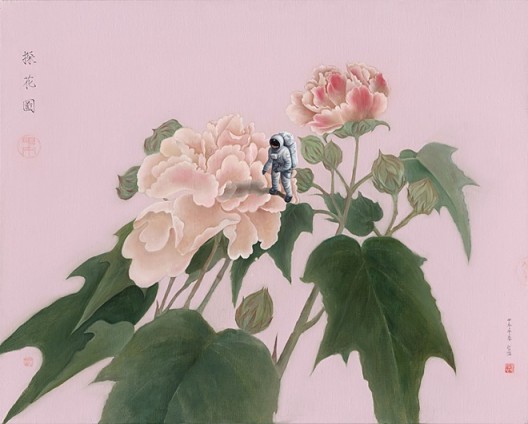
Chen Jiaye, “Highly Prized Flowers”, Oil on canvas, 80 x 100 cm, 2014
陈家业,《探花图》,布面油画,80 x 100 cm,2014
Chen Jiaye’s new works take classical works by Zhao Mengfu (1254 – 1322), Wu Yuanzhi (12th century) and other painters of the period since the Song and Yuan Dynasties as their mother lode, but they do not simply replicate these ink paintings in oil, but in a certain sense they restore material presence to these ancient paintings, and on their canvases they explore the various possibilities of their destinies. The artist uses his refined realistic technique to create the effect that these ancient paintings have been “torn up”, “crumpled”, “burnt” or “soaked”. At the same time as he removes a layer of illusion from the works, he creates another illusion, and the sense that the picture expresses fragmentation and incompleteness undoubtedly conveys the artist’s meditation on tradition in a contemporary encounter.
If we say that Chen Jiaye’s works are endowed with the powerful temperament of philosophical reflection, then Zhang Zheyi’s creative work expresses more of the elements of play and humour. He too works with oils, but his works are redolent of literati paintings (wen ren hua). He has an elevated awareness of traditional literature and culture, and his works draw on the traditional arts of poetry, calligraphy, painting, and seal carving; the ancient poems in rigorous classical rhyme and meter that adorn his paintings are his own compositions, as are the prefatory inscriptions that also appear on his works. Even though he includes cast iron toys, glass beads, and even airplanes and astronauts in his paintings, they have none of the cuteness or exaggeration we associate with work of the so-called “cartoon generation”, but instead exude a familiar and elegant classical temperament. Some of his works directly draw on visual motifs from classical painting, and in “Resilient in the Frost” and “Flying above the Azure Causeway” he reconstructs the classic schema of “orchids” from traditional flower and bird paintings, but when his sinuous orchids are subjected to closer scrutiny they turn out to be the vapour trails left by a fighter jet. The title “Flying above the Azure Causeway” is an alliteration of the Chinese reading of the name of the “B-45 Fighter” (Bi Futi Feiwu), and the artist deliberately chose to transliterate the sounds with words full of colour and visual sense; painted on paper, the text and images are mutually referential and playfully fascinating.
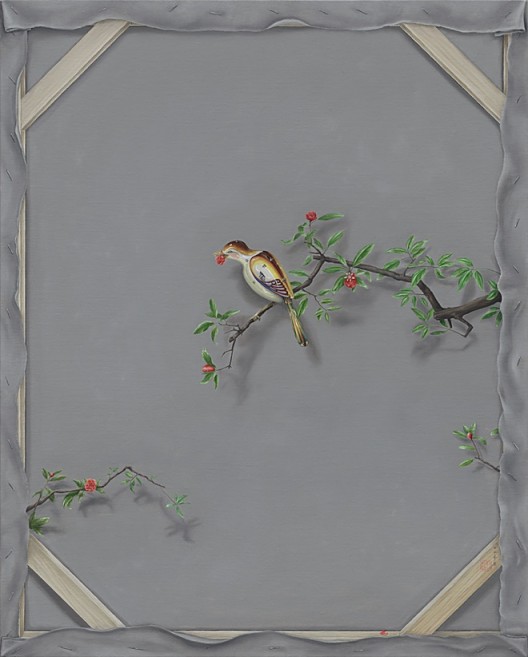
Chen Jiaye, “Yellow Oriole on the Pomegranate Branches”, Oil on canvas, 100 x 80 cm, 2014
陈家业,《榴花黄鸟图》,布面油画,100 x 80 cm,2014
In this exhibition, the two artists both pay particular homage to the leitmotif provided by the anonymous Song Dynasty masterpiece titled “Yellow Oriole on the Pomegranate Branches”, which they re-interpret in their different ways. To quote the lyric poem by Wen Tingjun (812 – 866), “looking at the flowers in the front and rear mirrors”, we see that their works inspired by the same original are very different, but we also see how their works simultaneously enhance and compliment each other.
Curator: Tang Zehui, Beijing, March 2014
Translated by Dr Bruce Gordon Doar
1. “Highly Prized Flowers” (Tan Hua): The title of this exhibition succinctly encapsulates many aspects of the Chinese tradition. The term tanhua originally referred to “viewing flowers”, the aristocratic pastime of gathering in parks and gardens, notably in spring, to view the blossoms. From the Song Dynasty onwards the term was used to describe the scholar in the imperial examinations who won the highly elusive third place.
2. Xu Bing, “If I don’t utilize these traditions, what are the alternatives”, Interviewed by Pan Ge, New York Times (Chinese online), Feb 24, 2014
